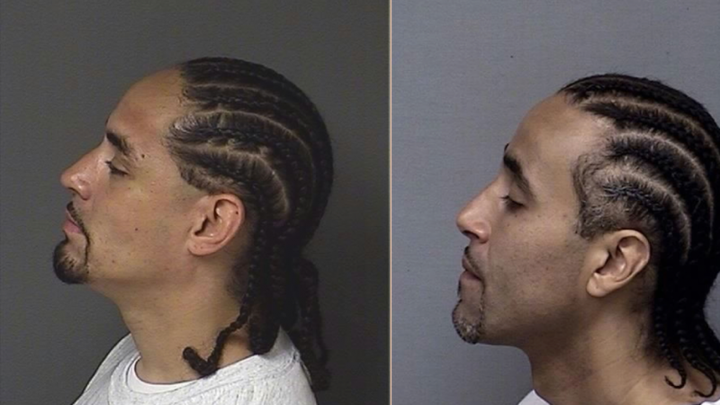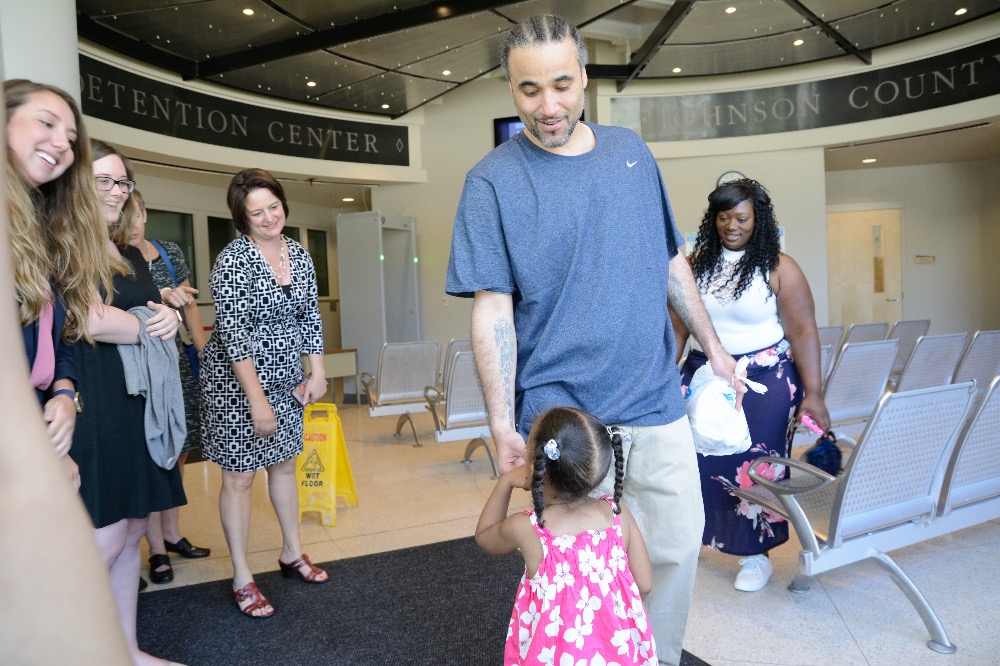
Richard Jones is Finally Free
Donation protected
Richard always told us that he spent the first 15 years of his prison sentence angry. He couldn't figure out why he was there. He was arrested, tried, and convicted for an aggravated robbery that he didn't commit. Richard was angry and confused — rightfully so. Finally, in September 2015, it all started to make sense.
Back in May of 1999, two men picked up a man named 'Rick' at a house in Kansas City, Kansas and went to a Walmart to get money for drugs. Once they pulled into the parking lot, 'Rick' jumped out of the vehicle, wrestled a woman to the ground in an attempt to steal her purse, grabbed her cell phone, and got back in the vehicle.
All of the witnesses described 'Rick' as a Hispanic or light skinned African American, but no one got a good look at 'Rick's face. Law enforcement identified the driver of the vehicle. The driver was taken to the police station to look at mugshots in an attempt to identify 'Rick.' Law enforcement typed the names 'Rick' and 'Richard' into their database. After viewing over 200 photographs, the driver eventually picked out Richard Jones. Law enforcement created this photo lineup to show the other witnesses.

Witnesses only remembered that the suspect had light skin, so they all chose the only light-skinned man in the lineup: Richard Jones.
Richard lived in Kansas City, Missouri and rarely ventured over to the Kansas side. He had no ties to the Kansas City, Kansas location where the suspect was originally picked up by the two men in the vehicle. He had alibi witnesses who testified that he was with them on the day of the crime. He didn't know any of the people who were in the vehicle when the crime was comitted. He also had never gone by the name 'Rick.'
The KU Law Project for Innocence in partnership with the Midwest Innocence Project had taken up Richard's case in 2015 because Richard was convicted solely on eyewitness testimony which is notoriously unreliable. However, his case was on the verge of being closed. Although everyone believed that Richard was innocent, legally there was nothing else they could do. There was no physical or forensic evidence to test. All of his appeals had been exhausted. In a last-ditch effort to help, Richard told the Project for Innocence interns at the time about a man named Ricky. Richard had been receiving comments from other inmates in prison about how he looked identical to Ricky. So the Project interns looked into it. This is what they found.


Ricky is pictured on the left, and Richard is pictured on the right.
Ricky not only has ties to the Kansas City, Kansas community, but also lived at the exact address where the suspect was picked up by the two men in the vehicle back in May of 1999.
The four photographs above were presented to the victim, the two men who had been in the vehicle, and the other eyewitness in the case. All four were asked to identify 'Rick.' Three of them did not even bother as they claimed that they couldn't distinguish between the men. One witness did choose who believed to be the suspect — and he chose Ricky. All four witnesses admitted that they would not have been able to tell the difference between Richard and Ricky at the time of the robbery. The man who prosecuted Richard back in 1999 even wrote an affidavit stating that this new information pointed to Ricky as the suspect, not Richard.
A motion claiming actual innocence under K.S.A. 60-1507 was filed in late 2016. This new evidence was presented to Johnson County Chief Judge Moriarty on June 7, 2017. Judge Moriarty listened to the three hour presentation of evidence and finally made a ruling from the bench:
"The court finds that when reviewing the statute, the court has to make a determination that actual innocence requires the defendant to show that it is more likely than not that no reasonable juror would have convicted the prisoner in light of the new evidence . . . This court has no doubt — although that isn't the standard — has no doubt that a jury would not be able to reach a determination that this defendant was guilty . . ."
Richard's conviction was finally overturned and, after spending 17 long years in prison, he was released from custody on June 8, 2017.
The proceeds of this GoFundMe will go directly to Richard Jones. Richard can never get those 17 years with his children (and now grandchildren) back, but every donation can help ease the injustice that took place. This money will help him assimilate back into society and allow him to spend time reconnecting with his family and friends after 17 long years. If anyone deserves a little bit of help from the community to get back on his feet, it's Richard Jones.
If you're unable to donate, please consider sharing Richard's story. In addition, feel free to check out the Midwest Innocence Project website, http://themip.org, to learn more about the important work being done to help innocent prisoners across the Midwest.
Any media inquiries can be directed to the KU Law Project for Innocence at https://law.ku.edu/innocence-project.



Back in May of 1999, two men picked up a man named 'Rick' at a house in Kansas City, Kansas and went to a Walmart to get money for drugs. Once they pulled into the parking lot, 'Rick' jumped out of the vehicle, wrestled a woman to the ground in an attempt to steal her purse, grabbed her cell phone, and got back in the vehicle.
All of the witnesses described 'Rick' as a Hispanic or light skinned African American, but no one got a good look at 'Rick's face. Law enforcement identified the driver of the vehicle. The driver was taken to the police station to look at mugshots in an attempt to identify 'Rick.' Law enforcement typed the names 'Rick' and 'Richard' into their database. After viewing over 200 photographs, the driver eventually picked out Richard Jones. Law enforcement created this photo lineup to show the other witnesses.

Witnesses only remembered that the suspect had light skin, so they all chose the only light-skinned man in the lineup: Richard Jones.
Richard lived in Kansas City, Missouri and rarely ventured over to the Kansas side. He had no ties to the Kansas City, Kansas location where the suspect was originally picked up by the two men in the vehicle. He had alibi witnesses who testified that he was with them on the day of the crime. He didn't know any of the people who were in the vehicle when the crime was comitted. He also had never gone by the name 'Rick.'
The KU Law Project for Innocence in partnership with the Midwest Innocence Project had taken up Richard's case in 2015 because Richard was convicted solely on eyewitness testimony which is notoriously unreliable. However, his case was on the verge of being closed. Although everyone believed that Richard was innocent, legally there was nothing else they could do. There was no physical or forensic evidence to test. All of his appeals had been exhausted. In a last-ditch effort to help, Richard told the Project for Innocence interns at the time about a man named Ricky. Richard had been receiving comments from other inmates in prison about how he looked identical to Ricky. So the Project interns looked into it. This is what they found.


Ricky is pictured on the left, and Richard is pictured on the right.
Ricky not only has ties to the Kansas City, Kansas community, but also lived at the exact address where the suspect was picked up by the two men in the vehicle back in May of 1999.
The four photographs above were presented to the victim, the two men who had been in the vehicle, and the other eyewitness in the case. All four were asked to identify 'Rick.' Three of them did not even bother as they claimed that they couldn't distinguish between the men. One witness did choose who believed to be the suspect — and he chose Ricky. All four witnesses admitted that they would not have been able to tell the difference between Richard and Ricky at the time of the robbery. The man who prosecuted Richard back in 1999 even wrote an affidavit stating that this new information pointed to Ricky as the suspect, not Richard.
A motion claiming actual innocence under K.S.A. 60-1507 was filed in late 2016. This new evidence was presented to Johnson County Chief Judge Moriarty on June 7, 2017. Judge Moriarty listened to the three hour presentation of evidence and finally made a ruling from the bench:
"The court finds that when reviewing the statute, the court has to make a determination that actual innocence requires the defendant to show that it is more likely than not that no reasonable juror would have convicted the prisoner in light of the new evidence . . . This court has no doubt — although that isn't the standard — has no doubt that a jury would not be able to reach a determination that this defendant was guilty . . ."
Richard's conviction was finally overturned and, after spending 17 long years in prison, he was released from custody on June 8, 2017.
The proceeds of this GoFundMe will go directly to Richard Jones. Richard can never get those 17 years with his children (and now grandchildren) back, but every donation can help ease the injustice that took place. This money will help him assimilate back into society and allow him to spend time reconnecting with his family and friends after 17 long years. If anyone deserves a little bit of help from the community to get back on his feet, it's Richard Jones.
If you're unable to donate, please consider sharing Richard's story. In addition, feel free to check out the Midwest Innocence Project website, http://themip.org, to learn more about the important work being done to help innocent prisoners across the Midwest.
Any media inquiries can be directed to the KU Law Project for Innocence at https://law.ku.edu/innocence-project.



Organizer and beneficiary
The Project for Innocence and Post Conviction Remedies at the University of Kansas School of Law
Organizer
Lawrence, KS
Richard Jones
Beneficiary